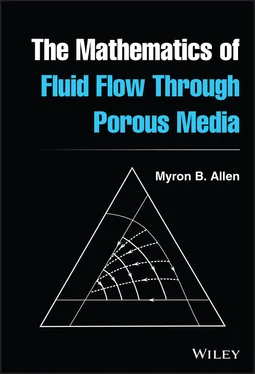Myron B. Allen, III - The Mathematics of Fluid Flow Through Porous Media
Здесь есть возможность читать онлайн «Myron B. Allen, III - The Mathematics of Fluid Flow Through Porous Media» — ознакомительный отрывок электронной книги совершенно бесплатно, а после прочтения отрывка купить полную версию. В некоторых случаях можно слушать аудио, скачать через торрент в формате fb2 и присутствует краткое содержание. Жанр: unrecognised, на английском языке. Описание произведения, (предисловие) а так же отзывы посетителей доступны на портале библиотеки ЛибКат.
- Название:The Mathematics of Fluid Flow Through Porous Media
- Автор:
- Жанр:
- Год:неизвестен
- ISBN:нет данных
- Рейтинг книги:5 / 5. Голосов: 1
-
Избранное:Добавить в избранное
- Отзывы:
-
Ваша оценка:
The Mathematics of Fluid Flow Through Porous Media: краткое содержание, описание и аннотация
Предлагаем к чтению аннотацию, описание, краткое содержание или предисловие (зависит от того, что написал сам автор книги «The Mathematics of Fluid Flow Through Porous Media»). Если вы не нашли необходимую информацию о книге — напишите в комментариях, мы постараемся отыскать её.
, distinguished professor and mathematician Dr. Myron B. Allen delivers a one-stop and mathematically rigorous source of the foundational principles of porous medium flow modeling. The book shows readers how to design intelligent computation models for groundwater flow, contaminant transport, and petroleum reservoir simulation.
Discussions of the mathematical fundamentals allow readers to prepare to work on computational problems at the frontiers of the field. Introducing several advanced techniques, including the method of characteristics, fundamental solutions, similarity methods, and dimensional analysis,
is an indispensable resource for students who have not previously encountered these concepts and need to master them to conduct computer simulations.
Teaching mastery of a subject that has increasingly become a standard tool for engineers and applied mathematicians, and containing 75 exercises suitable for self-study or as part of a formal course, the book also includes:
A thorough introduction to the mechanics of fluid flow in porous media, including the kinematics of simple continua, single-continuum balance laws, and constitutive relationships An exploration of single-fluid flows in porous media, including Darcy’s Law, non-Darcy flows, the single-phase flow equation, areal flows, and flows with wells Practical discussions of solute transport, including the transport equation, hydrodynamic dispersion, one-dimensional transport, and transport with adsorption A treatment of multiphase flows, including capillarity at the micro- and macroscale Perfect for graduate students in mathematics, civil engineering, petroleum engineering, soil science, and geophysics,
also belongs on the bookshelves of any researcher who wishes to extend their research into areas involving flows in porous media.


 where
where  .
. and
and  are real‐valued with
are real‐valued with  :
:
 ,
,  , and
, and  , respectively. All other physical quantities encountered in this book—except for one case involving temperature in Chapter 7—are derived quantities, having physical dimensions that are products of powers of
, respectively. All other physical quantities encountered in this book—except for one case involving temperature in Chapter 7—are derived quantities, having physical dimensions that are products of powers of  ,
,  , and
, and  .
. arises from Newton's second law
arises from Newton's second law  , where
, where  denotes mass and
denotes mass and  denotes acceleration:
denotes acceleration:
 require a way to assign numerical values to the physical quantities involved. We do this by comparison with standards, a process called measurement. For example, to assign a numerical value to the length of an object, we compare it to a length to which we have assigned a numerical value by fiat. A choice of standards for measuring
require a way to assign numerical values to the physical quantities involved. We do this by comparison with standards, a process called measurement. For example, to assign a numerical value to the length of an object, we compare it to a length to which we have assigned a numerical value by fiat. A choice of standards for measuring  ,
,  , and
, and  , applied consistently for all occurrences of length, mass, and time, defines a system of units. Changing the system of units typically changes the numerical values that we measure, the exception being dimensionlessquantities, which have dimension 1.
, applied consistently for all occurrences of length, mass, and time, defines a system of units. Changing the system of units typically changes the numerical values that we measure, the exception being dimensionlessquantities, which have dimension 1.










